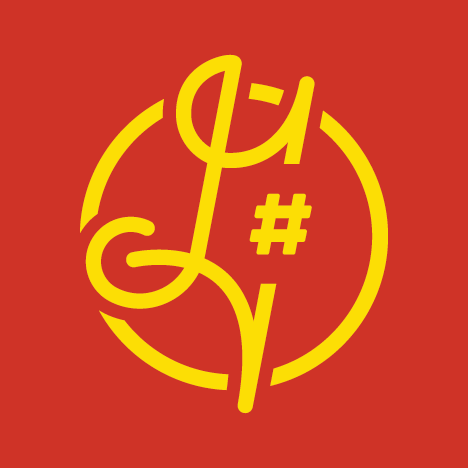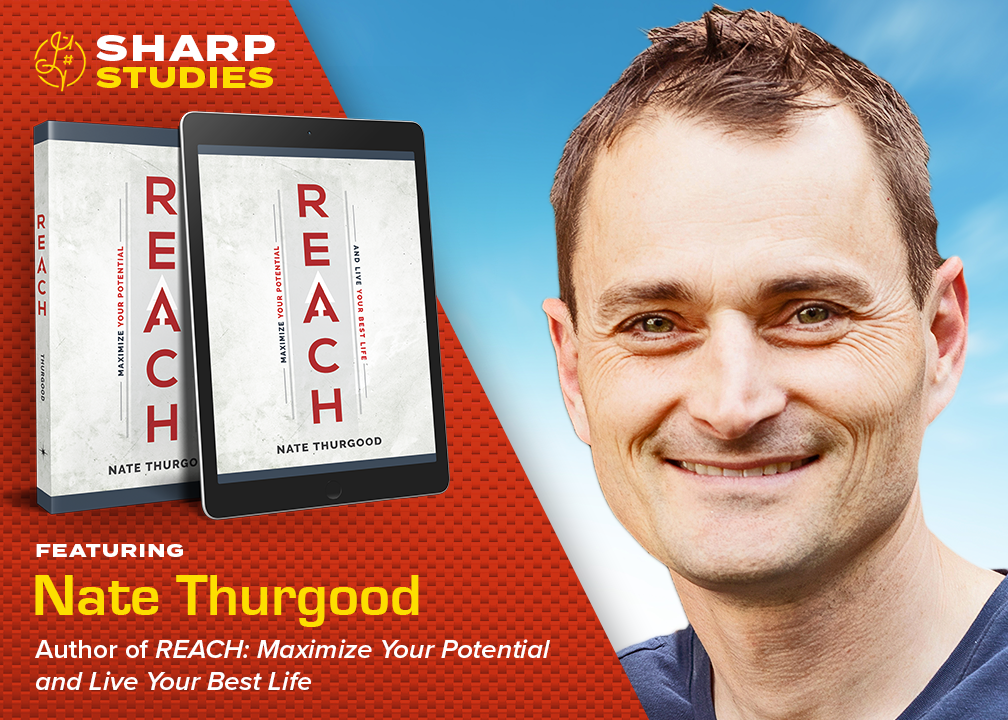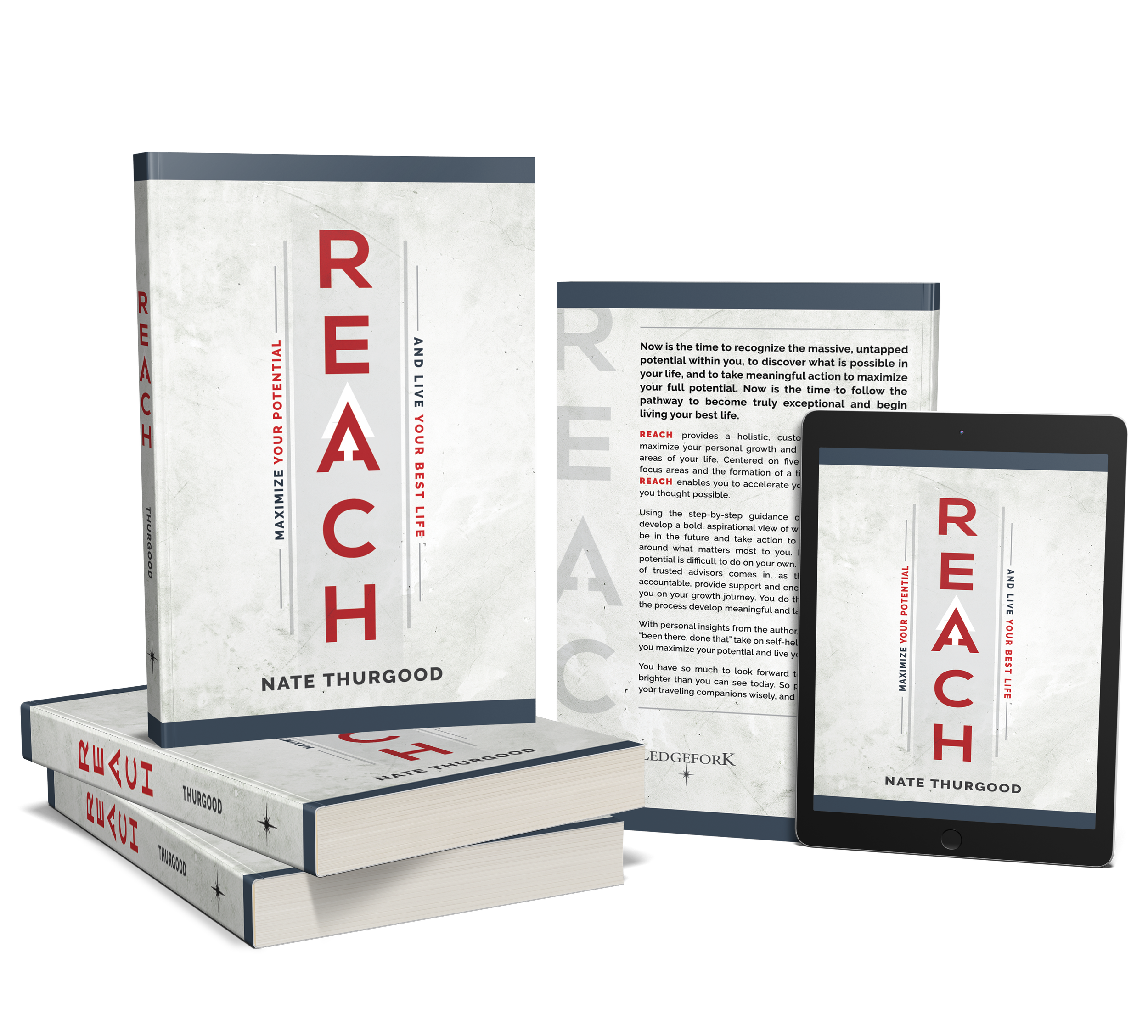SharpStudies #1: Nate Thurgood
A Note from George: This is the first in what will be a recurring series of interviews with authors who have worked with G Sharp Design. It’s an opportunity to talk about their experience in the design process, but also to celebrate them as a new authors.
—
Nate Thurgood of Dallas, TX is the author of REACH: How Maximize Your Potential and Live Your Best Life (available on Amazon). He recently worked with G Sharp Design on the full design of his book: jacket, layout, and ebook conversion. Nate and I collaborated for several months, and the result was a book that captured Nate’s vision and positioned him confidently as he went forward into the market place.
Nate was good enough to talk to me about his publishing journey, how he went about hiring a design resource, and his advice for authors who are staring down the book design process for the first time. (I also needled Nate, a father of five, for some parenting advice!)
Read on!
Nate, thanks for chatting with me today! Let’s start off with you telling us a bit about yourself.
NT: I am what you might call an accidental, first-time author. A few years ago during a period of great frustration with my life, I came up with a new concept for personal growth. Some friends and I have been using the approach since that time with a lot of success and I wanted to share it with others. That’s what ultimately led me to write the book, meet you, and to be here today.
Professionally, I work in M&A (mergers and acquisitions) for one of the largest companies in the world. I was also previously an entrepreneur. On the personal side of the house, I am happily married to my wife of nearly 20 years and am the father of five fun and lively kids.
You’re a published author now, but it all started somewhere. When was the earliest time you can remember thinking, “Maybe I should write a book about this”?
NT: It was a gradual process that started with taking small actions. When I initially came up with the idea for REACH, I thought it could make a compelling book. But I wasn’t looking to become an author. I was trying to find something that could help my own life.
So I started by implementing the concepts myself and bringing some friends along on that journey with me. After seeing the positive impact REACH was having on my own life, I decided to start writing. My primary purpose at that point was to help my partners and a few others who were using REACH to see my full vision. It wasn’t until my REACH partners heard I was writing and encouraged me to write a manuscript that I decided to make a run at writing a book.
What’s REACH all about? What inspired you to develop this framework?
NT: REACH is a personal growth and development framework that combines an individualized goal oriented approach with a support group that acts as a personal advisory council, accountability group, and friendship circle. As the book’s tagline suggests, the purpose of REACH is to help people to maximize their own unique potential and to live more meaningful, rich, and impactful lives.
As I mentioned earlier, the idea for REACH came to me during an unexpectedly difficult period of my life. From an outside perspective, I had what many would have said was an ideal life. And I should have felt fulfilled and satisfied. But that wasn't the case, and I didn't know what to do or how to improve my situation.
On a fateful day during this period, I made a simple change that ultimately led to a period of intense learning, self-reflection, and creative thinking. After months of deep thought an idea started to form. That idea was REACH.
Who do you think can most benefit from the book?
NT: Initially, I thought the concepts would most resonate with working professionals between 30 and 50 years of age, who are struggling to balance everything going on in their lives. While this is still probably the sweet spot, it’s pretty clear from my discussions with others and from the early reviews of the book that the concepts have much broader applicability.
For example, I’m finding that retirees are quite interested in REACH. Many people who are older lack meaningfully friends and connections, so the group concept in REACH is strongly resonating with my older reviewers. In fact, some have already formed their own REACH Groups.
The framework was intentionally designed to be usable by anyone. And my hope is that people of all walks of life will find value in the framework and begin implementing it in their lives.
GS: Let’s get to design! Talk about your headspace going into this phase of your publishing process. Were you excited, nervous, etc.?
NT: I was definitely both nervous and excited. Prior to writing the manuscript, my creativity had long been dormant. Fortunately, the writing process reignited my creative fire. By the time I arrived at the design phase, my creativity was peaking, so it was a thrill to go through that process.
At the same time, I didn’t know what to expect. I was a complete novice in book publishing and had no idea how the book design process worked. And the source I was relying on for guidance was a random website I’d found on the Internet that promised to hook me up with publishing pros.
So it was uncomfortable moving into the design phase and choosing a designer. Fortunately, I selected one who was an awesome partner.
We connected through a crowdsourcing platform. What led you to hire me onto the project over the other designers you considered?
NT: I looked at designers on the platform to find someone that I felt would fit my preferred design style - clean with subtle design elements. After a thorough search, I narrowed the list down to you and another designer and then requested bids.
While cost was important to me, design was my top priority. And on the whole, I liked your designs better than the other designer’s. So I was silently hoping that your bid would come in at or below the other designer’s bid.
I probably shouldn’t say this, but the other designer’s pricing was significantly higher than what you proposed and what research suggested was market pricing. The other bid also only included the cover! That made it easy to choose you.
How did the actual book design process compare to your expectations?
NT: As an entrepreneur, I worked with graphic designers, and I know not every designer uses the same approach so I wasn’t sure what to expect with you.
It was clear early on that we were going to mesh well. Starting with our initial kickoff meeting, the whole design process was so organized and smooth. You clearly communicated timelines, process, and expectations. You also seemed prepared and genuinely interested in making a great book, which I valued.
The actual design process was more fun than I expected. I eagerly counted the days until the designs came in like I was a kid at Christmas. And while it took a lot of iteration to get to the final design, each step in the process was enjoyable and helped to refine the design. I also was so happy with some of the creative design elements that you came up with, such as the interior section breaks, which I think look awesome.
“The actual design process was more fun than I expected. I eagerly counted the days until the designs came in like I was a kid at Christmas.”
On the whole, I was ecstatic with where the design landed and also greatly appreciated how seamlessly you worked with my final proofreader. Your responsiveness and positive, can-do attitude throughout the entire process went way beyond my expectations.
And the proof is in the pudding. My editorial reviews have consistently complimented the quality of the design. That’s a credit to you.
I appreciate that, but every successful collaboration is the result of two parties who want the best out of it so it’s a testament to how you approached the project as well.
To that end, what advice would you give to authors staring down the book design process for the first time?
NT: There are several things I’d suggest:
Find someone who has a design style that matches what you have in mind. While some designers (like you) can adapt to a wide variety of design preferences, most have a certain look and feel that they are comfortable using and you can see it in their designs.
Look at reviews or get a referral. It’s tough to judge how responsive someone will be, how well they can communicate, and whether your work styles will mesh. That’s where reviews and referrals can help. You had a bunch of positive reviews that raved about your work style. That gave me a lot of comfort in choosing you.
Get multiple bids. Every publishing professional takes a different approach to bidding for work. I found each of the bids that I received to be incredibly informative about what’s important to different people. Seeing these insights enabled me to refine my follow up questions and ensure alignment with my chosen partner.
Don’t be shy about providing input on the design. It’s ultimately your book, so you need to make sure the design matches what you want. A designer can only do so much and needs your guidance to know what hits and what doesn’t. You are also the most familiar with the book, so you’re best positioned to evaluate how a design fits.
Communicate clearly to ensure your deadlines and expectations are met. That starts by getting alignment upfront and partnering with someone who communicates well (like George).
Finally, have fun. The design phase is such an enjoyable part of the publishing process, so put on your creative hat and enjoy the journey.
What are your goals for the book? How will you define success?
NT: When I started writing, my primary goal was to help my own REACH partners to see the full vision for REACH and perhaps a few other people to improve and live happier lives. That’s already happened, so to some extent, I feel that my initial goal for the book has already been accomplished.
But as often happens, after I embarked on my journey my vision for what was possible changed and expanded. I now believe REACH can help many people live happier and more meaningful lives. And each individual life that is positively impacted by REACH is a success in my mind. Helping as many people as possible is obviously my desire, but I get so much joy in seeing the individual successes.
Beyond the outward goals and possibilities, writing and publishing REACH has been a huge personal accomplishment. I’ve learned so much about myself and my capacity for good through this process. And that’s been incredibly rewarding.
So even if the commercial adoption of the book falls flat, the joy I’ve found in this adventure has been more than worth the time and money I’ve put into it.
For those interested in learning more about the REACH framework, how can they connect with you and learn more about it?
NT: The starting point is the book, which provides a lot of detail on the REACH framework and how to implement it. I’ve also launched a website, where I’m posting additional content and building a community. And you can follow me on LinkedIn and Twitter, or email me at nate@reachpersonalgrowth.com.
Let’s close with some free parenting advice. I have a darling toddler who is a ball of fire, so keeping up with her, a business, and myself regularly feels like a balancing act. Meanwhile, you wrote and published a book while working a day job and raising five kids! What’s the secret?
NT: I can’t tell you how many times I’ve been asked a similar question (most often related to my demanding job) and I’m not sure that I have a perfect answer. But I’ll give it a shot.
First and foremost, I have an incredible wife. She hates when I praise her publicly, but the reality is that the book and my career success would not have been possible without her encouraging me and taking on extra burdens at home.
Beyond my wife’s support, I’d say that I learned by doing. When we had only one child, I remember feeling similar to you and wondering how we’d ever manage with more kids. But just as you learn and grow in other parts of your life, you learn and grow as a parent.
Things that seem difficult the first time you’re going through them become second nature your third, fourth, and fifth time experiencing them. That doesn’t necessarily make it easier; but that familiarity helps you gain confidence and better navigate the rough waters. I’ve also learned to deal with chaos better and to be far more productive than I ever imagined was possible when we had fewer kids.
It really comes down to prioritizing what’s important. If you really value it and you are willing to prioritize it, you’ll find a way to make it happen. I believe that’s true in all aspects of life.
Nate, thanks for taking the time. It was such a pleasure to work with you and I hope we get to do it again someday. I also appreciate you sharing your insights, as I think aspiring authors will benefit from your perspective.
NT: Well, thank you for having me and for being such an amazing partner. I’ve had such a fantastic time working with you and definitely hope we can continue the partnership in some way in the future.
###
Thanks to Nate for pulling back the curtain on his experience! This will be a recurring feature.


